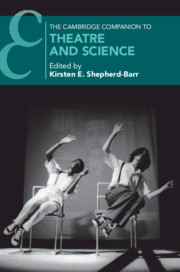Book contents
- The Cambridge Companion to Theatre and Science
- Cambridge Companions to Theatre and Performance
- The Cambridge Companion to Theatre and Science
- Copyright page
- Contents
- Illustrations
- Contributors
- Acknowledgements
- Introduction
- 1 Objectivity and Observation
- 2 Staging Consciousness
- 3 The Experimental/Experiential Stage
- 4 A Cave, a Skull, and a Little Piece of Grit
- 5 The Play at the End of the World
- 6 Bodies of Knowledge
- 7 Pathogenic Performativity
- 8 Theatres of Mental Health
- 9 Devised Theatre and the Performance of Science
- 10 Theatre and Science as Social Intervention
- 11 Acting and Science
- 12 Staging Cognition
- 13 Clouds and Meteors
- 14 ‘The Stage Hand’s Lament’
- Index
- References
9 - Devised Theatre and the Performance of Science
Published online by Cambridge University Press: 20 January 2021
- The Cambridge Companion to Theatre and Science
- Cambridge Companions to Theatre and Performance
- The Cambridge Companion to Theatre and Science
- Copyright page
- Contents
- Illustrations
- Contributors
- Acknowledgements
- Introduction
- 1 Objectivity and Observation
- 2 Staging Consciousness
- 3 The Experimental/Experiential Stage
- 4 A Cave, a Skull, and a Little Piece of Grit
- 5 The Play at the End of the World
- 6 Bodies of Knowledge
- 7 Pathogenic Performativity
- 8 Theatres of Mental Health
- 9 Devised Theatre and the Performance of Science
- 10 Theatre and Science as Social Intervention
- 11 Acting and Science
- 12 Staging Cognition
- 13 Clouds and Meteors
- 14 ‘The Stage Hand’s Lament’
- Index
- References
Summary
Chapter 9: This chapter begins by noting that as science has become more interdisciplinary and recognized as a form of contingent knowledge circulated across cultural fields, devising has emerged as a suitable method for creating performances with scientific content and themes. By virtue of its multivocality (involving a number of authors), its multimodal forms of storytelling and address (through language, dance, physicalization, digital media, installation and site-specific environments, and the like), and its presentational modes, devised performance can often render scientific ideas performative, capturing not just what they ‘are’ but what they ‘do’ and how they disseminate in the public understanding. Across scientific fields that are increasingly interrelated, devised performance provides new ways to move beyond merely conveying scientific ideas, choosing instead to invite spectators actively to map domains of knowledge and construct ideas that are constantly in transit.
Keywords
- Type
- Chapter
- Information
- The Cambridge Companion to Theatre and Science , pp. 131 - 145Publisher: Cambridge University PressPrint publication year: 2020

